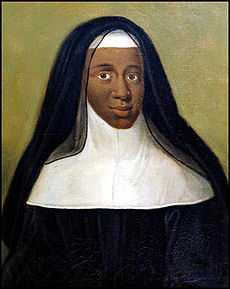Louise Marie Thérèse (The Black Nun of Moret)

Louise Marie-Thérèse also known as The Negroid Nun of Moret (16 November 1664 - 1732 in Moret-sur-Loing) was a French nun, the object of a gossip story in the 18th century, where she is pointed out as the daughter of the Queen of France, Maria Theresa of Spain. Her existence is mentioned in several different sources.[1][2][3]
Life
The Black Nun of Moret, Louise Marie-Thérèse (1664–1732) was a Benedictine nun in the abbey of Moret-sur-Loing. She was called the "Mauresse de Moret" ("Mooress of Moret"), and a portrait of her exists in the Bibliothèque Sainte Geneviève in Paris. The research done by the Société de l'histoire de Paris et d'Ile-de-France, published in 1924 by Honoré Champion éditions,[4] concluded that this pastel portrait was painted around 1680 by the same hand which painted the series of twenty-two pastel portraits of Kings of France, from Louis IX to Louis XIV, between 1681 to 1683 on the initiative of Father Claude Du Molinet (1620–1687), librarian of Sainte Geneviève abbey. No less than 6 memorialists have devoted paragraphs to her: she is mentioned in the memoirs of Madame de Maintenon, the Grande Mademoiselle, Madame de Montespan, Duke of Saint-Simon, Voltaire and Cardinal Dubois.
Shortly after the death of the French Queen Maria Theresa of Spain in 1683, wife of Louis XIV, courtiers pointed out this woman as the black daughter the Queen allegedly once gave birth to. The nun however seemed convinced of her royal birth, and it is told by Saint-Simon that she once greeted the Dauphin as "my brother". A letter sent on June 13, 1685, by the Secretary of the House of King to Mister De Bezons, general agent of the clergy, and the pension's patent of 300 pounds granted by King Louis XIV to the nun Louise Marie-Thérèse on October 15, 1695, "to be paid to her all her life in this convent or everywhere she could be, by the guards of the Royal treasure present and to come" confirm this opinion.
Historical notes on the exhumations made on 1793 in the abbey of Saint-Denis where French royalty are buried, published by the French national museum of monuments, reveal the following: "The same day October 14, after the workmen's dinner, around 3 PM, we continued the extraction of the other coffins of the Bourbons; instance Louis XIII, died in 1643, 42 years old; Louis XIV, died in 1715, 76 years old; Marie de Médicis, second wife of Henri IV, died in 1642, 68 years old; Anne of Austria, wife of Louis XIII, died in 1666, 64 years old; Maria Theresa of Spain, wife of Louis XIV, died in 1683, 45 years old; Louis, Dauphin, son of Louis XIV, died in 1711, 49 years old. Note: some of these bodies were well preserved, especially the one of Louis XIII; but Louis XIV skin was black like ink."[5]
References
- ↑ Mémoirs of the Duchess of Montpensier Vol. 2, VII;
- ↑ Memoirs of Madame de Montespan, Ch. XL;
- ↑ Memoirs of the Duc de Saint-Simon (1675-1755) Vol 2, Ch. XII
- ↑ Honoré Champion, ed. (1924). Mémoires de la Société de l'histoire de Paris et de l'Île-de-France (in French) 47. Société de l'histoire de Paris et de l'Ile-de-France (France).
- ↑ Lenoir, Alexandre (1801). Musée des monumens français: ou Description historique et chronologique des statues en marbre et en bronze, bas-reliefs et tombeaux des hommes et des femmes célèbres, pour servir à l'histoire de France et à celle de l'art; ornée de gravures; et augm. d'une dissertation sur les costumes ... (in French) 2. De l'Imprimerie de Guilleminet.